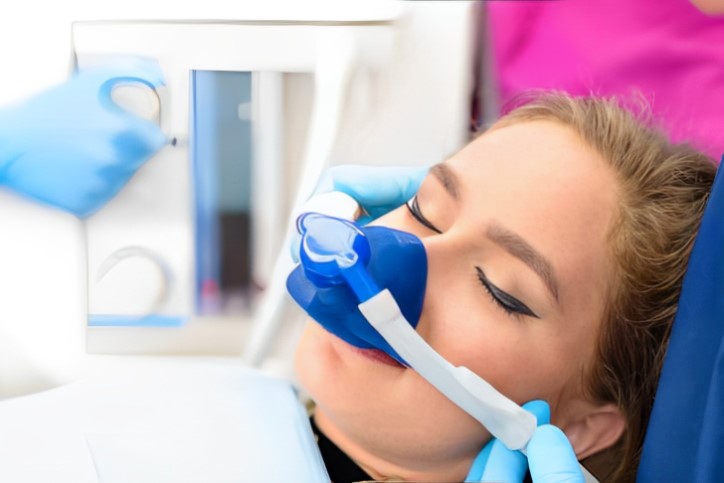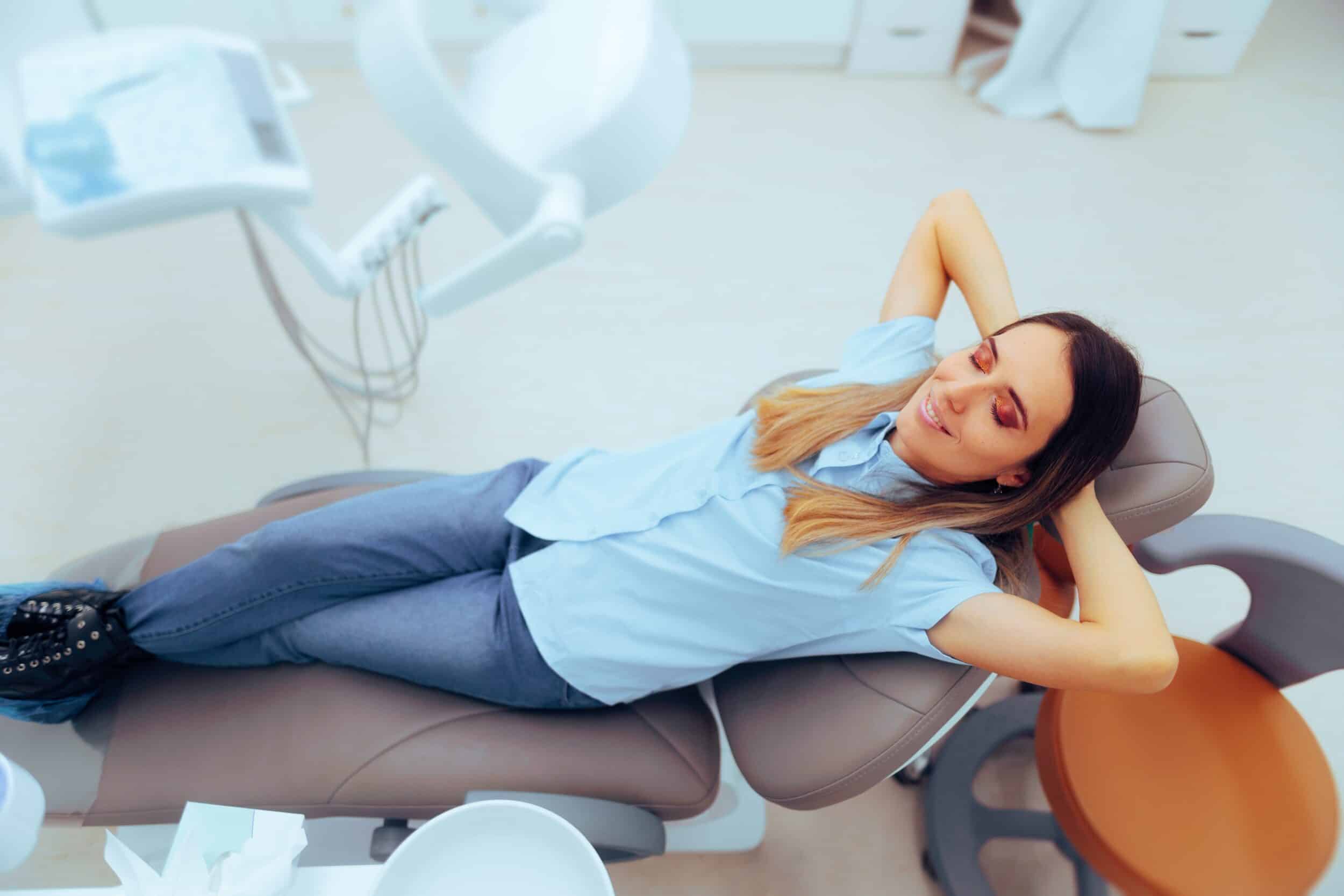In Address The Dental Anxiety With Sedation Dentistry
Because our family has been taking care of people’s teeth since 1922, the date our grandfather started his dental practice in Milwaukee, we know all about dental anxiety. For some, the thought of a trip to the dentist can create dread akin to sitting in the theater at the latest horror movie. There’s no explaining it — it could be the sound of a drill, the pulling down of the hanging dental light, maybe even the overall smell of the office — but the fear is real. At Hampton Dental Associates, we treat our patients like our family, so we do everything we can to make you feel at ease in our offices. To that end, we offer sedation dentistry.

What is Sedation Dentistry?
Sedation dentistry involves the use of medications to keep patients relaxed during dental procedures. Sedation dentistry doesn’t really include general anesthesia (although it is a level of sedation) because in sedation dentistry patients are usually awake and able to respond to requests from the dentist. The sedation simply allows the patient to relax and overcome his or her anxiety.
What are the levels of sedation?
There are four levels of sedation:
Minimal Sedation
When under minimal sedation, you are awake but relaxed. Your dentist can induce minimal sedation through the inhalation of nitrous oxide or “laughing gas”. This is done with a mask placed over the patient’s face. The patient may also elect to for oral sedation with a pill, usually Halcion, a drug in the same drug family as Valium.
Moderate Sedation
Also called “conscious sedation,” you may slur your words when talking and not remember most of what occurred during the procedure. Your dentist can induce this level of sedation with a pill as well.
Deep Sedation
While in deep sedation, you will be on the edge of consciousness but your dentist can still awake you. Your dentist will likely use and IV to achieve this level of sedation. This allows the dentist to continuously adjust your level of sedation.
General Anesthesia
You’re completely unconscious. Your dentist will also administer general anesthesia intravenously.
What types of sedation are used?
Inhaled minimal sedation involves breathing nitrous oxide, also known as “laughing gas,” to help the patient relax. The patient uses a mask placed over the nose to breath a mixture of nitrous oxide is combined with oxygen. After the procedure, the gas wears off quickly. The patient usually can drive home following the procedure.
Oral sedation can be minimal to moderate. The patient takes a pill (usually Halcion, in the same drug family as Valium) usually about 30 minutes before the procedure. The pill makes the patient drowsy. Oral sedation is most commonly associated with sedation dentistry.
IV sedation works more quickly as the sedative drug if your dentist administers it through a vein. The method allows the dentist to adjust sedation levels continually.
Deep sedation and general anesthesia are delivered intravenously, as well. A patient under general anesthesia cannot be awakened easily until the anesthesia wears off or is reversed using a different medication.
We use sedation with medication and nitrous oxide at Hampton Dental Associates and for more complex surgeries we refer to our specialists when I.V. sedation is required.
Am I a candidate for sedation dentistry?
Patients can misunderstand the difference between sedation and anesthesia. Anesthetic ensures you’ll feel nothing during our dental procedures. Sedation isn’t to handle pain — that’s the role of anesthesia — but to help patients deal with strong feelings of fear and anxiety that arise when they visit the dentist. After receiving sedation and successfully completing their appointment, patients often completely change how they view dental appointments going forward. Sedation could be a great option if you:
- Have difficulty overcoming anxiety about the dentist
- Have a low pain threshold
- Have very sensitive teeth
- Have a very strong gag reflex
- Need a large amount of work done
Once you are sedated and comfortable, we then properly numb, or anesthetize, the area we are working on, ensuring your procedure is pain free.
How safe is sedation dentistry?
At Hampton Dental Associates we provide oral sedation and nitrous oxide, referring to specialists if IV sedation is necessary. Oral sedation has an amnestic effect. While technically a side effect, most patients love this benefit because they have no recollection of their visit to our offices or of their procedure. Oral sedatives can also cause dry mouth, headaches, dizziness, and occasional nausea, but these pass quickly.
Nitrous oxide can create pressure changes in the middle ear and in the intestines. This can lead to short-term pain, but this is a very rare reaction. In most cases, nitrous oxide is very safe and very effective for alleviating your anxiety.
We don’t perform IV sedation at Hampton, but the biggest risk with IV sedation is over-sedation. Reaching too deep a level of sedation can be dangerous for medically compromised patients. Over-sedation can also lead to respiratory depression. Continual monitoring of the patient’s vital signs mitigates these risks. That’s why we refer these situations to a specialist.
Can you feel any pain during sedation dentistry?
As discussed above, there is a little misconception here. Sedation is not anesthesia. Sedation has the goal of helping the patient overcome his or her anxiety or fear that they associate with the dentist. Sedation has the pleasant side benefit of usually also creating an amnesia-like effect, so the patient has little or no memory of their appointment.
Anesthesia is what keeps you comfortable and pain-free. Modern dental anesthesia ensures our Hampton Dental Associates patients don’t feel anything during any of our treatments.
Is there recovery after dental sedation?
There isn’t any recovery from our sedation dentistry at Hampton, but you will need some planning, depending upon the type of sedation you choose.
If you have nitrous oxide to take the edge off, as soon as the mask is removed the effects wear off almost instantly. That means you’re fully capable of safely driving yourself home after your appointment.

If you opt for oral sedation, you’ll need to arrange to have someone drive you home. That’s because the effects of sedation last from two to four hours after your appointment. With sedation, you are not allowed to drive a car for 12 hours afterwards.
How long before I can drive if I have dental sedation?
If you had nitrous oxide, its effects wear off almost as soon as we remove the mask. In just five or 10 minutes, you have no after-effect, and you can drive without risk.
But if you’ve had oral sedation, Wisconsin law (and that of every other state) declares you must wait at least 12 hours before driving a car.
What is the difference between sedation dentistry and sleep dentistry?
This is a bit of a misnomer. Patients sometimes think they will be put “under,” as they are with general anesthesia. This is not the case. With nitrous oxide, oral, and IV sedation, you’re always awake, but sedated.
Dentists rarely use general anesthesia. This is used for more involved oral surgery, such as wisdom teeth or various periodontal procedures.
Benefits of Sedation Dentistry
Sedation dentistry is an appealing option for patients who experience dental anxiety or have specific treatment needs. Below are some of the key benefits:
- Reduces Anxiety and Fear: Feel calm and relaxed, even during complex or lengthy procedures. This is particularly useful for individuals with dental phobias or negative experiences at the dentist.
- Minimizes Discomfort: Patients are comfortable throughout their treatment. It can reduce sensitivity to pain, noises, and other sensations that may cause discomfort.
- Allows for Longer Procedures: Dentists can perform multiple procedures in one visit, reducing the number of appointments needed. This is especially helpful for patients requiring extensive dental work.
- Improves Patient Cooperation: For individuals with special needs, a strong gag reflex, or who may have trouble sitting still for longer periods, sedation dentistry makes it easier for the dentist to provide care effectively.
- Enhances Efficiency: Patients under sedation are less likely to move or react during treatment, allowing the dentist to work more efficiently and achieve precise results.
- Provides a Positive Dental Experience: Feeling at ease during the visit can encourage patients to maintain regular dental check-ups and develop a more positive attitude toward oral care.
Keep in mind that we do not perform IV sedation at Hampton Dental Associates. Patients can enjoy the benefits listed above with safe and effective oral sedation (in the form of medication such as anxiolytics) or nitrous oxide (commonly known as laughing gas).
Sedation Dentistry Appointment Preparation
For a smooth and safe sedation dentistry experience, follow these steps:
- Follow Fasting Guidelines: Your dentist may instruct you to avoid eating or drinking for a certain period, depending on the type of sedation used.
- Arrange Transportation: For oral sedation, you’ll need someone to drive you to and from your appointment, as the effects can linger.
- Wear Comfortable Clothing: Opt for loose-fitting, comfortable clothes to ensure ease during the procedure.
- Discuss Medications: Ask your dentist if you should take your regular medications before the appointment and inform them of any new prescriptions.
- Avoid Alcohol and Tobacco: Refrain from consuming alcohol or using tobacco products at least 24 hours before the procedure.
- Bring a Companion: For added reassurance, bring a trusted friend or family member to support you during the visit.
- Plan Recovery Time: Set aside time to rest and recover after the appointment, as the sedation may leave you drowsy.
Why Choose Hampton Dental Associates for Sedation Dentistry
At Hampton Dental Associates, we have been providing compassionate dental care to the Milwaukee community for over four generations. Our deep understanding of dental anxiety is rooted in decades of experience and a legacy of care passed down through our family. We are committed to making every patient feel comfortable and welcome, offering sedation dentistry to ensure a stress-free and relaxed experience during any procedure. Whether you are managing dental phobia, undergoing a complex treatment, or simply seeking a more comfortable visit, we tailor our approach to meet your individual needs.
Dr. Richard Winter leads our practice with a patient-first philosophy: “Dentistry is a process, not an event.” This approach ensures personalized, high-quality care delivered at your pace. Combining traditional family values with cutting-edge techniques, we offer the finest dental solutions, from sedation dentistry to advanced restorative and cosmetic treatments. Join our Hampton Dental family and experience a legacy of exceptional care designed to help you achieve optimal oral health with confidence and comfort.
Have a Relaxing Visit with Sedation Dentistry in Milwaukee, WI
At Hampton Dental Associates, we believe that everyone deserves a stress-free, comfortable dental experience. Don’t let dental anxiety stand in the way of your care—call us at 414-464-9021 today to learn more about sedation dentistry and schedule your appointment.
Check out our Dental Blog >>
Read our Patient Case Studies >>
Hampton Dental Associates is proud to offer affordable dentistry programs to help you regain your perfect smile.
Learn more about our affordable dentistry options.



